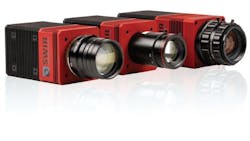With its acquisition in July of SWIR Vision Systems (Research Triangle Park, NC, USA), onsemi (Scottsdale, AZ, USA) says it plans to bring down the cost of SWIR sensors, spurring the technology’s use in a wide array of commercial, industrial, and defense applications.
SWIR, or short-wave infrared, is a band of light in the electromagnetic spectrum that is beyond human vision. It is typically described as the wavelength between 0.9–1.7 micrometers μm but can also be classified as 0.7–2.5 μm.
"In terms of the nonvisible imaging side of machine vision, it's a pretty significant acquisition," comments David Dechow, founder of Machine Vision Source (Salisbury, NC, USA).
Publicity surrounding the acquistion of SWIR Vision Systems by a large semiconductor company may foster curiosity about SWIR as a machine vision technology, and could lead to greater adoption of it to solve some application challenges. "SWIR has a lot of potential and is a relatively overlooked solution in machine vision," Dechow says. However, he adds, it is more of a niche than mainstream technology in machine vision.
How SWIR is Applied in Machine Vision
SWIR light reacts to some common substances differently than visible light. This characteristic makes SWIR more useful than visible light in machine vision applications involving these substances.
“These advanced SWIR sensors are able to see through dense materials, gases, fabrics and plastics, which is essential across many industries, particularly for industrial applications such as surveillance systems, silicon inspection, machine vision imaging and food inspection. In autonomous vehicle imaging, the higher spectra will create better visibility to see through difficult conditions such as extreme darkness, thick fog or winter glare,” onsemi explains.
Related: Quantum Dot Technology is Enabling Machine Vision Applications
For example, using SWIR technology, a machine vision application could see through a plastic jug of milk to assess the fill level of the liquid inside.
SWIR sensors typically use one of two types of technology: indium gallium arsenide (InGAas) or colloidal quantum dot (CQD), which is what sensors from SWIR Vision Systems use.
InGAas sensors are more common today, and numerous companies sell InGAas cameras with SenSWIR sensors from Sony (Tokyo, Japan). Dechow suspects Sony's strategy is to apply its scale and expertise in manufacturing to bring down the cost of InGAas sensors, noting that the company has "succeeded to a certain extent."
Given onsemi’s size and manufacturing expertise, it should also be able to implement a similar strategy with the CQD sensor from SWIR Vision Systems, he says.
Indeed, onsemi says it "will combine its silicon-based CMOS sensors and manufacturing expertise with the CQD technology to deliver highly integrated SWIR sensors at lower cost and higher volume.”
As a result of the acquisition, SWIR Vision Systems is now a wholly owned subsidiary of onsemi, but it will continue to operate out of its current location in North Carolina.
Related: SWIR Imaging Enables Many Types of Machine Vision Applications
SWIR Vision Systems first introduced its Acuros CQD sensor technology at The Vision Show in 2018. The cameras have a CQD-on-CMOS sensor and provide imaging in the visible, near infrared (NIR) and SWIR spectrums. With either a USB 3.0 or GigE Vision interface, they are available in a variety of sensor resolutions and are compatible with a range of SWIR lenses.
SWIR imaging is used in many types of applications such as medical imaging, chemical sensing, silicon inspection, laser beam profiling, and surveillance.
About the Author
Linda Wilson
Editor in Chief
Linda Wilson joined the team at Vision Systems Design in 2022. She has more than 25 years of experience in B2B publishing and has written for numerous publications, including Modern Healthcare, InformationWeek, Computerworld, Health Data Management, and many others. Before joining VSD, she was the senior editor at Medical Laboratory Observer, a sister publication to VSD.


